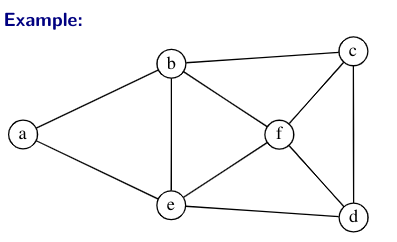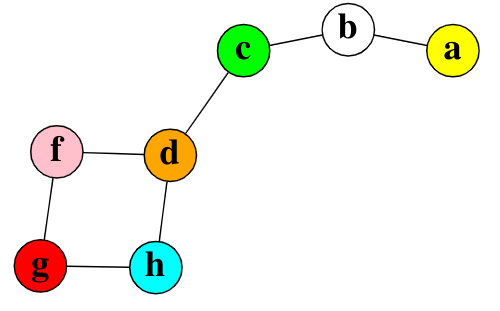8.9 KiB
8.9 KiB
- #MA284 - Discrete Mathematics
- Previous Topic: Convex Polyhedra
- Next Topic: Trees
- Relevant Slides:
-
Vertex Colouring
- There are maps that can be coloured with a single colour, two colours, three colours, or four colours.
- For all maps, no matter how complicated, at most four colours is sufficient.
-
Colouring Graphs
- If we think of a map as a way of showing which regions share borders, then we can represent it as a graph, where:
- A vertex in the graph corresponds to a region in the map.
- There is an edge between two vertices in the graph if the corresponding regions share a border.
- Colouring regions of a map corresponds to colouring vertices of the graph. Since neighbouring regions in the map must have different colours, so too must adjacent vertices.
- More precisely:
- Vertex Colouring: An assignment of colours to the vertices of a graph.
- Proper Colouring: If the vertex colouring has the property that adjacent vertices are coloured differently, then the colouring is called proper.
- Minimal Colouring: A proper colouring that is done with the fewest possible number of colours.
- Lots of different proper colourings are possible. If the graph has
vvertices, then clearly at mostvcolours are needed. However, usually, we need far fewer. -
Chromatic Numbers
- What is the chromatic number of a graph? #card
card-last-interval:: 2.8
card-repeats:: 1
card-ease-factor:: 2.6
card-next-schedule:: 2022-11-17T10:50:36.778Z
card-last-reviewed:: 2022-11-14T15:50:36.779Z
card-last-score:: 5
- The chromatic number of the graph, written
\chi(G)is the smallest number of colours needed to get a proper vertex colouring of a graphG.
- The chromatic number of the graph, written
-
Example
- Determine the chromatic number of the graphs
C_2,C_3,C_4, &C_5. background-color:: green-
\chi(C_2) = 2 -
\chi(C_3) = 3 -
\chi(C_4) = 2 -
\chi(C_3) = 5
-
- Determine the chromatic number of the
K_n&K_{p,q}for anyn,p,q. background-color:: green-
\chi(K_4) = 4 -
\chi(K_n) = n -
\chi(K_{3,3}) = 2 -
\chi(K_{p,q}) = 2
-
- Determine the chromatic number of the graphs
- In general, calculating
\chi(G)is not easy, but there are some ideas that can help. For example, it is clearly true that if a graph hasvvertices, then-
1 \leq \chi(G) \leq v
-
-
Cliques
- If the graph happens to be complete, then
\chi(G) = v. If it is not complete, then we can look at cliques in the graph.- What is a clique of a graph? #card
card-last-interval:: -1
card-repeats:: 1
card-ease-factor:: 2.5
card-next-schedule:: 2022-11-15T00:00:00.000Z
card-last-reviewed:: 2022-11-14T16:14:53.505Z
card-last-score:: 1
- A clique is a subgraph of a graph, all of whose vertices are connected to each other.
- (Clique numbers will not be on the exam).
- What is the clique number of a graph? #card
card-last-interval:: -1
card-repeats:: 1
card-ease-factor:: 2.5
card-next-schedule:: 2022-11-23T00:00:00.000Z
card-last-reviewed:: 2022-11-22T13:37:29.890Z
card-last-score:: 1
- The clique number of a graph,
G, is the number of vertices in the largest clique inG.
- The clique number of a graph,
- Lower Bound: The chromatic number of a graph is at least its clique number.
- Upper Bound:
\chi(G) \leq \Delta(G) + 1, where\Delta(G)denotes the largest degree of any vertex in the graphG.
- What is a clique of a graph? #card
card-last-interval:: -1
card-repeats:: 1
card-ease-factor:: 2.5
card-next-schedule:: 2022-11-15T00:00:00.000Z
card-last-reviewed:: 2022-11-14T16:14:53.505Z
card-last-score:: 1
- If the graph happens to be complete, then
- What is the chromatic number of a graph? #card
card-last-interval:: 2.8
card-repeats:: 1
card-ease-factor:: 2.6
card-next-schedule:: 2022-11-17T10:50:36.778Z
card-last-reviewed:: 2022-11-14T15:50:36.779Z
card-last-score:: 5
- If we think of a map as a way of showing which regions share borders, then we can represent it as a graph, where:
-
Algorithms for
\chi(G)- In general, finding a proper colouring for a graph is hard. There are some algorithms that are efficient, but not optimal. We'll look at two:
- The Greedy Algorithm.
- The Welsh-Powell Algorithm.
- The Greedy Algorithm is simple & efficient, but the result can depend on the ordering of the vertices.
- The Welsh-Powell Algorithm is slightly more complicated, but can give better colourings.
-
Greedy Algorithm #card
card-last-interval:: -1 card-repeats:: 1 card-ease-factor:: 2.5 card-next-schedule:: 2022-11-15T00:00:00.000Z card-last-reviewed:: 2022-11-14T16:22:55.701Z card-last-score:: 1-
- Number all the vertices. Number your colours.
- Give a colour to vertex 1.
- Take the remaining vertices in order. Assign each one the lowest numbered colours that is different from the colours of its neighbours.
-
-
Welsh-Powell Algorithm #card
card-last-interval:: -1 card-repeats:: 1 card-ease-factor:: 2.5 card-next-schedule:: 2022-11-15T00:00:00.000Z card-last-reviewed:: 2022-11-14T15:51:29.529Z card-last-score:: 1-
- List all vertices in decreasing order of their degree (i.e., largest degree first). If two or more share the same degree, list them in any way you want.
- Colour the first listed vertex (with the first unused colour).
- Work down the list, giving that colour to all vertices not conencted to one previously coloured.
- Cross (verb.) coloured vertices of the list, and return to the start of the list.
-
- In general, finding a proper colouring for a graph is hard. There are some algorithms that are efficient, but not optimal. We'll look at two:
-
Eulerian Paths & Circuits
- Recall that a path is a sequence of adjacent vertices in a graph.
- What is a Eulerian Path? #card card-last-interval:: -1 card-repeats:: 1 card-ease-factor:: 2.5 card-next-schedule:: 2022-11-15T00:00:00.000Z card-last-reviewed:: 2022-11-14T16:18:26.028Z card-last-score:: 1
- Recall that a circuit is a path that begins & ends at that same vertex, and no edge is repeated.
- What is an Eulerian Circuit? #card
card-last-interval:: -1
card-repeats:: 1
card-ease-factor:: 2.5
card-next-schedule:: 2022-11-15T00:00:00.000Z
card-last-reviewed:: 2022-11-14T16:21:29.522Z
card-last-score:: 1
- An Eulerian Circuit (also called an Eulerian Cycle) is an Eulerian path that that starts & finishes on at the same vertex.
- If a graph has such a circuit, we say that it is Eulerian.
- It is possible to come up with a condition that guarantees that a graph has an Eulerian Path, and, additionally, one that ensures that ensures that it has an Eulerian Circuit.
- To begin with, we'll reason that the following graph could not have an Eulerian circuit, although it does have an Eulerian path.
- Suppose, first, that we have a graph that ==does have an Eulerian circuit.== Then, for every edge in the circuit that "exits" a vertex, there is another that "enters" that vertex. So, every vertex must have even degree.
- A graph has an Eulerian Circuit if and only if every vertex has even degree.
- Next, suppose that a graph==does not have an Eulerian circuit==, but does have an Eulerian path. Then, the degree at the "start" & "end" verticwes must be odd, and every other vertex has even degree.
- A graph has an Eulerian Path if and only if it has either zero or two vertices with odd degree.
-
Hamiltonian Paths & Cycles
- What is a Hamiltonian Path? #card
card-last-interval:: 2.8
card-repeats:: 2
card-ease-factor:: 2.6
card-next-schedule:: 2022-11-24T08:06:13.770Z
card-last-reviewed:: 2022-11-21T13:06:13.770Z
card-last-score:: 5
- A Hamiltonian Path is a graph that visits every vertex exactly once.
- What is a Hamiltonian Cycle? #card
card-last-interval:: -1
card-repeats:: 1
card-ease-factor:: 2.5
card-next-schedule:: 2022-11-15T00:00:00.000Z
card-last-reviewed:: 2022-11-14T16:23:21.600Z
card-last-score:: 1
- A Hamiltonian Cycle is a cycle which visits the start / end vertex twice, and every other vertex exactly once.
- A graph that has a Hamiltonian Cycle is called a Hamiltonian Graph.
- Important examples of Hamiltonian Graphs include cycle graphs, complete graphs, & graphs of the platonic solids.
- In general, the problem of finding a Hamiltonian path or cycle in a large graph is hard - it is known to be NP-complete. However, there are two relatively simple sufficient conditions to testing if a graph is Hamiltonian:
-
Ore's Theorem #card
card-last-interval:: -1 card-repeats:: 1 card-ease-factor:: 2.5 card-next-schedule:: 2022-11-15T00:00:00.000Z card-last-reviewed:: 2022-11-14T15:50:30.834Z card-last-score:: 1- A graph with
vvertices, wherev \geq 3, is Hamiltonian if, for every pair of non-adjacent vertices, the sum of their degrees is\geq v.
- A graph with
-
Dirac's Theorem #card
card-last-interval:: -1 card-repeats:: 1 card-ease-factor:: 2.5 card-next-schedule:: 2022-11-15T00:00:00.000Z card-last-reviewed:: 2022-11-14T16:15:37.739Z card-last-score:: 1- A simple graph with
vvertices, wherev \geq 3, is Hamiltonian if every vertex has degree\geq v / 2.
- A simple graph with
-
- What is a Hamiltonian Path? #card
card-last-interval:: 2.8
card-repeats:: 2
card-ease-factor:: 2.6
card-next-schedule:: 2022-11-24T08:06:13.770Z
card-last-reviewed:: 2022-11-21T13:06:13.770Z
card-last-score:: 5


